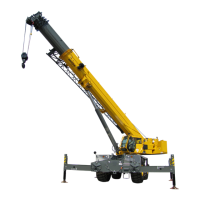National Crane 01-22-2019 Control # 051-08 1-21
1300A INTRODUCTION
Yearly Inspection
Inspect the total length of wire rope annually or more often if
necessitated by adverse conditions. Only inspect the outer
surface of the wire rope. Do not attempt to open the strands
of the rope. Items to include in the yearly inspection are
items listed in the daily inspection plus the following:
• reduction of rope diameter below nominal diameter.
• severely corroded or broken wires at end connections.
• severely corroded, cracked, bent, worn, or improperly
applied end connections.
• areas subjected to rapid deterioration such as:
- sections in contact with saddles, equalizer sheaves,
or other sheaves where wire rope travel is limited.
- sections at or near terminal ends where corroded or
broken wires may protrude.
- sections in contact with stationary surfaces where
abrasion or chafing may take place as a result of
equipment vibration.
• boom nose sheaves, hook block sheaves, boom jib
sheaves, auxiliary boom nose sheaves, and hoist drums
for wear. Damaged sheaves or hoist drums can
accelerate wear and cause rapid deterioration of the
wire rope.
Boom Extension and Retraction Cables
Periodic Inspection
It is recommended that a weekly inspection of all boom
extension and retraction cables be performed using the
following guidelines. The inspection shall cover all visible
areas of the extension and retraction cables of an assembled
boom. Note that extending and/or retracting the boom may
be required to access visual inspection holes.
The inspection shall cover the entire length of the extension
and retraction cables of a disassembled boom prior to
reassembly.This inspection should be used to monitor
progressive degradation and to discover severe damages
necessitating wire rope replacement or equipment repair.
Inspection criteria are as follows:
• reduction of rope diameter below nominal diameter.
• severely corroded or broken wires at end connections.
• severely corroded, cracked, bent, worn, or improperly
applied end connections.
• deterioration in areas such as:
- sections in contact with saddles, equalizer sheaves,
or other sheaves where rope travel is limited.
- sections of wire rope at or near terminal ends where
corroded or broken wires may protrude.
- sections of wire rope in contact with stationary
surfaces where abrasion or chafing may take place
as a result of equipment vibration.
• damaged or wobbly boom extension and retraction
sheaves which can cause rapid deterioration of wire
rope.
• unusual cable sag/stretch. Be sure cables used in sets
all have an equal tension applied. Repeated need for
adjustment of an individual cable is evidence of cable
stretch and indicates the need for a more thorough
inspection to determine and correct the cause.
Wire Rope Replacement (All Wire Rope)
No precise rules can be applied to wire rope replacement
because of the variables involved. Determining the condition
of the wire rope depends largely upon the judgement of a
qualified person.
The information below is excerpted from a National
Consensus Standard as referenced by Federal Government
Agencies and Manitowoc CraneCARE recommendations to
help determine when wire rope needs to be replaced. Wire
rope shall be taken out of service when any of the following
conditions exist:
• In running ropes, six randomly distributed broken wires
in one lay or three broken wires in one strand in one lay
(Figure 1-6).
• Kinking, crushing, bird caging, or any other damage
resulting in distortion of the rope structure.
• Evidence of heat damage.
• Reductions from nominal diameter of more than 5%.
• In standing ropes, more than two broken wires in one lay
in sections beyond end connections or more than one
broken wire at an end connection.
• In rotation resistant rope, two randomly distributed
broken wires in six rope diameters or four randomly
distributed broken wires in 30 rope diameters.
• Severe corrosion as evidenced by pitting.
6
1
2
3
4
5
6
One Lay
FIGURE 1-6
One lay is parallel to the rope center-line and is the
distance for one strand to make a complete spiral
around the rope.

